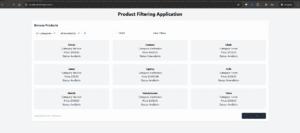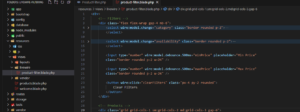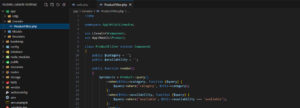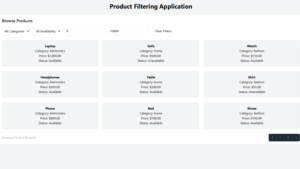Introduction
In modern web development, handling requests efficiently is key to building secure and scalable applications. Laravel, one of the most popular PHP frameworks, makes this task easier with its powerful Middleware system. Middleware acts as a bridge between a request and a response, allowing developers to filter HTTP requests entering the application. In this article, we will dive deep into Laravel Middleware, exploring its importance, how it works, and the best practices for using it effectively.
What is Middleware?
Definition and Role in Web Applications
Middleware is essentially a filter that sits between the user’s request and the server’s response. It can intercept and manipulate incoming requests or outgoing responses, making it highly useful for adding functionalities such as authentication, logging, or data filtering without bloating the core logic of your application.
Importance of Middleware in Laravel
Laravel’s middleware is a critical component for enhancing security, managing requests, and adding additional logic at various points in the request lifecycle. It simplifies tasks such as enforcing authentication, handling CORS (Cross-Origin Resource Sharing), logging requests, and much more, making your application both more secure and maintainable.
Overview of the Article
Throughout this article, you will gain a comprehensive understanding of how Laravel middleware works, how to set it up, and how to make the most of it in your projects. By the end, you will be equipped to create and manage middleware in your Laravel applications confidently.
Understanding the Basics of Laravel Middleware
Laravel’s Request Lifecycle
In Laravel, the request lifecycle is the process that handles every HTTP request that enters the application. The lifecycle begins when a request enters the application and ends when a response is returned to the client. Middleware plays an essential role in this cycle by sitting between the HTTP request and the response, allowing the developer to manipulate the flow of information.
How Middleware Fits into the Request-Response Cycle
Laravel middleware intercepts HTTP requests before they reach the controller and manipulates them based on predefined logic. This could mean validating a user’s authentication, logging request data, or even altering the response before it’s sent back to the user. Essentially, middleware helps create a pipeline for processing requests and responses efficiently.
Core Concepts
Laravel organizes middleware into a middleware stack, which consists of layers through which the requests pass. Middleware can be categorized as either global (applied to every request) or route-specific (applied only to certain routes). These middleware can be configured and stacked to create a highly flexible and powerful system for request handling.
Common Use Cases
Laravel middleware can be used for a variety of purposes, including:
- Authentication: Verifying user credentials before granting access to specific routes.
- Logging: Recording data about incoming requests for analytics or debugging.
- CORS: Managing Cross-Origin Resource Sharing to control which domains can access your resources.
These use cases are just the beginning of what middleware can achieve in a Laravel application.
Setting Up Middleware in Laravel
Creating Middleware
Creating middleware in Laravel is a straightforward process. You can use Laravel’s Artisan CLI to generate middleware quickly. The command to create middleware is:
php artisan make:middleware CustomMiddlewareThis will generate a new middleware class inside the app/Http/Middleware directory. Once the middleware is created, you can add your custom logic within the handle method of the class.
Structure of a Middleware Class
A typical middleware class in Laravel includes the handle method, which takes two parameters: the request and a closure. This method allows you to inspect and manipulate the request before it reaches the controller or modify the response before it is sent back to the client.
public function handle($request, Closure $next) {
// Custom logic
return $next($request);
}Registering Middleware
Once you’ve created your middleware, you need to register it so that Laravel is aware of its existence. Middleware can be registered globally or at the route level:
Global Middleware Registration
Global middleware is registered in the app/Http/Kernel.php file under the $middleware property. This type of middleware is executed on every HTTP request.
protected $middleware = [
// other middleware
\App\Http\Middleware\CustomMiddleware::class,
];Route-Specific Middleware Registration
For middleware that only applies to specific routes, you can register it in the $routeMiddleware property of the same Kernel.php file:
protected $routeMiddleware = [
'custom' => \App\Http\Middleware\CustomMiddleware::class,
];Applying Middleware to Routes
Once your middleware is registered, you can apply it to individual routes or route groups using route definitions in your routes/web.php or routes/api.php file:
Route::get('/dashboard', [DashboardController::class, 'index'])->middleware('custom');You can also apply middleware to route groups for more complex applications:
Route::middleware(['auth', 'custom'])->group(function () {
Route::get('/dashboard', [DashboardController::class, 'index']);
Route::get('/profile', [ProfileController::class, 'index']);
});Using Middleware Aliases
Middleware aliases make it easier to apply middleware without writing out the full class name. You can create aliases in the Kernel.php file under $routeMiddleware, as shown above. Then, use the alias when assigning middleware to routes.
Types of Middleware in Laravel
Global Middleware
Global middleware is executed on every HTTP request that enters the application. This type of middleware is useful for tasks that should happen on every request, such as logging, session handling, or adding security headers.
Global middleware is registered in the app/Http/Kernel.php file under the $middleware array. Here’s an example of how global middleware is defined:
protected $middleware = [
\App\Http\Middleware\VerifyCsrfToken::class,
\App\Http\Middleware\CheckForMaintenanceMode::class,
];Some common examples of global middleware include:
- VerifyCsrfToken: Ensures that cross-site request forgery protection is enabled.
- CheckForMaintenanceMode: Checks if the application is in maintenance mode before processing the request.
Route Middleware
Route middleware is only applied to specific routes or route groups, allowing for more granular control over which middleware is executed for certain parts of your application. These are typically used for things like authentication and access control.
To assign route middleware, first register it in the $routeMiddleware array in Kernel.php:
protected $routeMiddleware = [
'auth' => \App\Http\Middleware\Authenticate::class,
];Once registered, you can apply the middleware to routes like this:
Route::get('/dashboard', [DashboardController::class, 'index'])->middleware('auth');This ensures that only authenticated users can access the /dashboard route.
Middleware Groups
Middleware groups allow you to organize middleware into logical groups that can be applied to routes or controllers in a simplified manner. Laravel includes some predefined groups, such as web and api, which are used to differentiate between routes meant for web pages and API endpoints.
Middleware groups are registered in the Kernel.php file under the $middlewareGroups array:
protected $middlewareGroups = [
'web' => [
\App\Http\Middleware\EncryptCookies::class,
\Illuminate\Cookie\Middleware\AddQueuedCookiesToResponse::class,
],
'api' => [
'throttle:api',
\Illuminate\Routing\Middleware\SubstituteBindings::class,
],
];Using middleware groups simplifies your routes by allowing you to apply multiple middleware at once:
Route::middleware(['web'])->group(function () {
Route::get('/', [HomeController::class, 'index']);
});This improves code organization and reduces repetition.
Creating Custom Middleware
Step-by-Step Guide
Laravel allows you to create custom middleware to fit your application’s specific needs. Follow these steps to generate and implement custom middleware in your Laravel application.
Generating Custom Middleware
To generate custom middleware, use Laravel’s Artisan CLI with the following command:
php artisan make:middleware CustomMiddlewareThis will create a new file in the app/Http/Middleware directory.
Implementing Custom Logic in the handle Method
After generating the middleware, open the newly created class and implement the desired logic within the handle method. The method accepts the request and a closure, which represents the next middleware in the stack or the controller that will handle the request.
public function handle($request, Closure $next)
{
// Add custom logic here
return $next($request);
}In this example, you can add custom authentication checks, input validation, or other logic before allowing the request to proceed to the next layer.
Practical Examples
Custom Authentication Checks
For instance, you can create custom authentication middleware to ensure that a user is logged in with specific roles before proceeding:
public function handle($request, Closure $next)
{
if (!$request->user() || !$request->user()->hasRole('admin')) {
return redirect('home');
}
return $next($request);
}This middleware will redirect users who are not administrators to the homepage.
Input Validation and Sanitization
You can also use middleware to sanitize incoming request data:
public function handle($request, Closure $next)
{
$request->merge(['input_field' => htmlspecialchars($request->input('input_field'))]);
return $next($request);
}This sanitizes input before passing it to the controller for further processing.
Middleware Priority and Ordering
Understanding Middleware Priority
When multiple middleware are applied to a route, Laravel ensures that they are executed in a specific order. By default, the middleware are executed in the order they are listed in the middleware stack. However, you can explicitly define the priority in the $middlewarePriority array located in the app/Http/Kernel.php file.
How Laravel Determines Middleware Execution Order
Laravel checks the order of middleware based on the $middlewarePriority array. Middleware listed higher in this array will be executed before those listed lower. This is especially useful when you have middleware that depend on the result of another middleware to function properly.
Here’s an example of the $middlewarePriority array:
protected $middlewarePriority = [
\App\Http\Middleware\Authenticate::class,
\Illuminate\Routing\Middleware\SubstituteBindings::class,
// Other middleware
];Configuring Middleware Priority
You can modify the $middlewarePriority array to adjust the order in which middleware are executed. For example, if you have custom middleware that must run before Laravel’s authentication middleware, simply add your custom middleware above Authenticate::class in the priority array.
Avoiding Common Conflicts
When working with middleware, conflicts can arise if dependent middleware are not executed in the correct order. Ensuring the correct execution order in the $middlewarePriority array can help avoid these issues. Always test middleware interactions carefully to ensure everything runs as expected.
Terminable Middleware
What is Terminable Middleware?
Terminable middleware is a special type of middleware in Laravel that allows you to perform actions after the response has been sent to the user. While most middleware focuses on intercepting requests before they are processed, terminable middleware gives you the ability to carry out post-response tasks like logging or resource cleanup.
Implementing Terminable Middleware
To make middleware terminable, you simply need to include a terminate method in your middleware class. This method will be executed after the response has been sent to the client. Here’s an example:
public function terminate($request, $response)
{
// Logic to be executed after the response
Log::info('Request handled');
}The terminate method accepts the request and response objects, allowing you to inspect the data for further processing if needed.
Use Cases
Terminable middleware is especially useful in scenarios where you need to perform actions after the response has been sent back to the user. Some common use cases include:
- Logging Response Data: Storing details about the response for later analysis, without delaying the user’s experience.
- Cleaning Up Resources: Closing database connections or clearing temporary files after the response has been delivered.
Practical Middleware Examples
Authentication Middleware
Authentication middleware is one of the most common types of middleware used in Laravel. It ensures that users are authenticated before accessing certain routes. Laravel provides a built-in authentication middleware that can be applied to routes like this:
Route::get('/dashboard', [DashboardController::class, 'index'])->middleware('auth');This middleware checks if the user is logged in and redirects them to the login page if they are not.
CORS Middleware
CORS (Cross-Origin Resource Sharing) middleware allows you to control which domains can access your resources. This is crucial when building APIs that are accessed by clients hosted on different domains. You can create custom CORS middleware or use packages like Laravel CORS to handle this easily.
Rate Limiting Middleware
Rate limiting middleware is used to control the number of requests a user can make within a certain timeframe, preventing abuse or overloading of the server. Laravel provides a built-in rate limiting middleware, which can be applied like this:
Route::middleware('throttle:60,1')->group(function () {
Route::get('/api/data', [DataController::class, 'index']);
});This example limits the user to 60 requests per minute.
Custom Logging Middleware
Custom logging middleware can be used to track details about incoming requests and outgoing responses. For example, you can log the request data for debugging or monitoring purposes:
public function handle($request, Closure $next)
{
Log::info('Incoming request', ['url' => $request->url(), 'data' => $request->all()]);
return $next($request);
}This logs the request URL and data before passing it to the next middleware or controller.
Advanced Middleware Techniques
Conditional Middleware Execution
There are cases where you may want to apply middleware only under certain conditions. Laravel makes it easy to apply conditional middleware based on logic within the middleware class. For example, you can choose to execute a middleware only for requests coming from a certain IP address:
public function handle($request, Closure $next)
{
if ($request->ip() !== '123.456.789.0') {
return redirect('home');
}
return $next($request);
}This middleware will only allow access to users coming from the specified IP address, redirecting others to the homepage.
Middleware for API vs. Web Routes
In Laravel, API routes and web routes often require different middleware due to the distinct nature of these requests. Laravel separates these routes using the web and api middleware groups, which you can find in Kernel.php:
Route::middleware('web')->group(function () {
// Web routes
});
Route::middleware('api')->group(function () {
// API routes
});The web middleware group applies session handling and CSRF protection, which are not needed for APIs. In contrast, the api group includes rate limiting and does not maintain session state.
Chaining Middleware with Controllers
You can assign middleware directly to controller methods using the middleware method in the controller’s constructor. This technique is useful when you want to apply middleware to specific methods within a controller rather than all routes:
class DashboardController extends Controller
{
public function __construct()
{
$this->middleware('auth')->only('index');
}
public function index()
{
return view('dashboard');
}
}In this example, the auth middleware will only be applied to the index method of the DashboardController.
Testing and Debugging Middleware
Writing Tests for Middleware
Testing middleware ensures that the logic within your middleware works as expected. Laravel provides built-in tools to help you write unit tests for your middleware. You can simulate requests and check if your middleware behaves correctly under different conditions. Here’s an example of how to test a custom middleware:
public function test_custom_middleware_blocks_unauthorized_users()
{
$response = $this->get('/dashboard');
$response->assertRedirect('home');
}This test checks if the /dashboard route redirects unauthorized users to the home page.
Using Laravel’s Testing Tools
Laravel provides several useful methods for testing middleware, such as assertStatus, assertRedirect, and assertSee to validate responses and behavior. These tools help ensure that your middleware behaves as expected in various scenarios.
Debugging Tips
When debugging middleware, Laravel’s logging system can be highly effective. You can log request details inside your middleware to track issues:
Log::info('Middleware executed', ['url' => $request->url()]);This will output the log information in your log files, helping you trace the execution path and identify potential problems.
Tools for Monitoring Middleware Behavior
In addition to Laravel’s logging capabilities, tools like Sentry or Rollbar can be integrated with your application to monitor middleware behavior in real-time. These tools provide valuable insights into errors, performance issues, and request data.
Best Practices for Using Middleware
Organizing Middleware Effectively
To maintain a clean and scalable codebase, it is essential to organize middleware effectively. Group related middleware together and use middleware groups (like web and api) to apply multiple middleware at once. For example, you can organize middleware related to API security and rate limiting into one group.
Always ensure your middleware files are well-named and stored in appropriate directories. For instance, middleware dealing with user authentication can be placed in an Authentication directory within the Http/Middleware folder to improve clarity and organization.
Performance Considerations
Middleware adds overhead to your application, as it needs to be executed for every request. To minimize performance issues, follow these practices:
- Use Global Middleware Sparingly: Only register middleware globally if it is required for all requests. Otherwise, apply it only to specific routes.
- Optimize Middleware Logic: Keep the logic inside middleware as lightweight as possible. If complex processing is needed, delegate it to a service class or the controller.
- Cache Responses: Use Laravel’s caching mechanisms to reduce the need for executing middleware on every request, especially for routes that serve static content or don’t change often.
Security Best Practices
Middleware plays a crucial role in securing your Laravel application. Follow these best practices to ensure middleware enhances security without introducing vulnerabilities:
- Use CSRF Protection: Always include CSRF protection on routes that involve form submissions, especially in web applications. Laravel’s
VerifyCsrfTokenmiddleware can handle this automatically. - Limit Access with Authentication Middleware: Protect sensitive routes with the
authmiddleware to ensure only authenticated users can access them. - Validate Input: Use middleware to validate and sanitize incoming request data, especially for API endpoints, to prevent injection attacks.
Conclusion
Recap of Key Points
Middleware is a powerful feature in Laravel that allows you to handle HTTP requests and responses efficiently. It plays a crucial role in enhancing the security, performance, and maintainability of your application. By using middleware, you can easily manage tasks such as authentication, logging, and CORS, while keeping your application’s core logic clean and organized.
Importance and Versatility of Middleware in Laravel
As we have seen, middleware is highly versatile and can be applied in various situations, from enforcing user authentication to throttling API requests. Its flexibility allows developers to tailor it to their specific needs, whether they are building a web app or an API. By properly leveraging middleware, you can create more robust and scalable Laravel applications.
Encouragement to Implement Middleware
If you are not already using middleware to its full potential, now is the time to start. Middleware can greatly simplify your application by separating concerns, enhancing security, and improving performance. Take the time to create custom middleware and organize it effectively for maximum impact.
Further Resources
- Laravel Official Middleware Documentation – The official Laravel documentation offers a complete guide to middleware.
- Laracasts – Video tutorials that cover Laravel middleware and much more.
- Fruitcake Laravel CORS Middleware – A popular package for handling CORS in Laravel.






